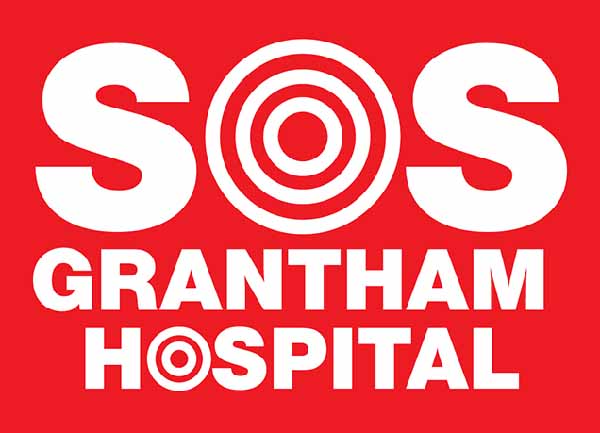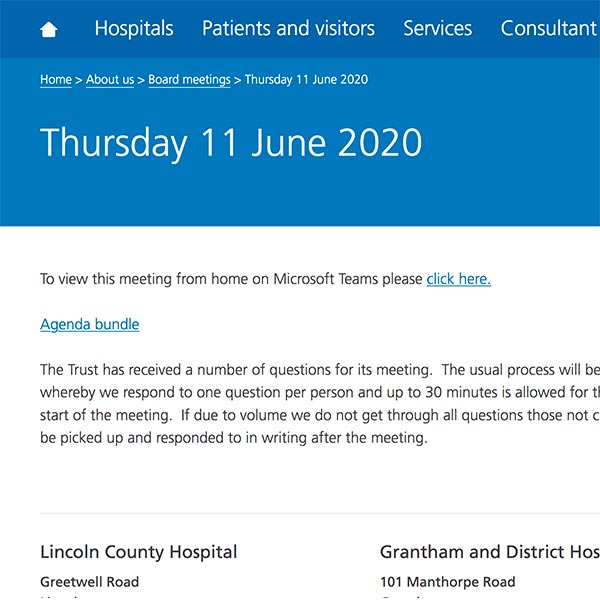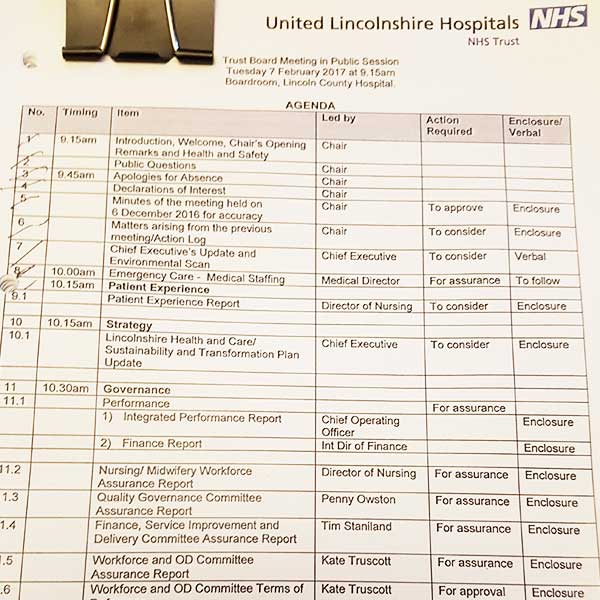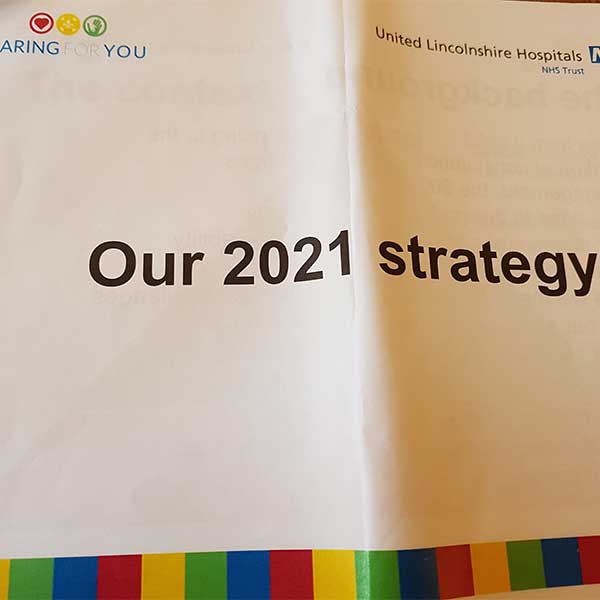Lincolnshire Sustainability and Transformation Plan 2016
During May 2016 ULHT presented strategic plans (Lincolnshire Sustainability and Transformation Plan) for the delivery of acute medical services across Lincolnshire. The plans included the downgrade of Grantham Hospital Accident Emergency Unit & Boston Pilgrim A&E with future A&E services for Lincolnshire County Council to be centred on Lincoln Hospital which is struggling to cope with existing workloads and stretched to capacity.
In response to this proposal SOS Grantham Hospital started an online petition in line with a similar petition at Boston.
Grantham Hospital serves 120,000 people. It is located on the A1 East Midlands corridor north of Peterborough and on the East Coast mainline railway. The county of Lincolnshire is the fourth largest in the country and the next nearest A&E unit from Grantham is at least 23 miles away. The area has a diverse mixed rural and urban community with the residents and businesses of over 40 villages and 4 towns affected being Grantham, Newark, Sleaford and Melton Mowbray. The public transport network in the vicinity is poor with virtually no bus service running in the evenings and overnight. The area has a significant number of single parent households and low income households. Many have no car.
Short Term Overnight Closure of Grantham Hospital A&E between 18:30-09:00 Mon-Sunday inclusive
On 10 August, despite operational reports indicating issues with the East Midlands Ambulance Service and failures to meet targets at Lincoln Hospital A&E, ULHT stated they planned to close Grantham Hospital A&E overnight for ‘safety reasons’ arguing that there was an unsustainable shortage of medium grade A&E doctors across the Trust. The closure has resulted in local people being denied any access to A&E services and fails to reflect the vital life sustaining role Grantham A&E plays. The unit may provide emergency resuscitation and support critically ill patients until they are either admitted at Grantham Hospital or transferred elsewhere. Having stated the night time closure would be initially for 3 months ULHT have recently stated that the unit will be closed until at least February 2017.
This decision is putting lives at risk.
In August 2016 the United Lincolnshire Hospital Trust (ULHT) closed Grantham Hospital A&E from 18:30 to 09:00 every night at one week’s notice. The closure took place as local people wait to hear what long term strategic plans ULHT have for our hospital.
ULHT argue that the ‘temporary closure’, now extended until February 2017, was for safety reasons due to the shortage of medium grade doctors across the ULHT A&E units. In particular there were concerns that Lincoln Hospital was unable to cope with high levels of demand.
Local campaigners do not accept ULHTs proposals. We:
- Dispute the statement made by ULHT that the changes will provide better ‘patient safety’.
Residents and those working within the Grantham Hospital catchment area argue that under NHS Principals the needs of everyone should have been considered by ULHT. Local emergency medical needs have been ignored as significant delays in treatment may occur as a result of a reliance on an over stretched EMAS service at night due to non existent public transport and high taxi fares beyond the reach of many local householders.
- Argue that ULHT have deliberately misled key decision makers and the media in order to gain support for their night closure and downgrading of Grantham Hospital A&E
ULHT are publicly stating that: ‘…people will see little change at Grantham Hospital if A&E was downgraded because emergency cases are sent to Lincoln, Boston and other hospitals.
SOS Grantham Hospital and other campaigners argue that this statement is totally misleading.
People in the Grantham area are at risk as a result of the night time closures.
The following conditions were treated at Grantham Hospital prior to closure at night.
| Conditions treated at Grantham Hospital A&E |
| Serious heart attacks:
Patients who collapse and need resuscitation, ventilation and Advanced Life support Problems with the brain and/or nervous system: Meningitis Encephalitis ( viral infection of the brain) Guillain Barre syndrome (an acute paralysing illness) Epilepsy and fits Unconscious patients Drug withdrawal Alcohol withdrawal (eg the DT’s) Delirium Liver Encephalopathy ie delirium resulting from liver disease Heart problems: Heart attacks/Acute Coronary syndrome which are non STEMI ( ie do not require urgent coronary angiogram) Atrial Fibrillation (fast irregular heart) and electrical cardioversion ( ie electric shock treatment to correct the heart) SVT ( palpitations with fast heart rate) Heart failure Pulmonary oedema (excessive fluid in the lungs causing difficulty breathing) Infective Endocarditis ( infected heart ) Heart block causing sudden collapse Conditions relating to lungs: Acute asthma exacerbation/bronchitis Acute COPD ( Chronic Obstructive Airway disease or smoke damaged lungs) including provision of non invasive ventilation Pneumonia Pulmonary Embolism ( clots in the lung) Lung Fibrosis with low oxygen Lung cancer and its complications Pleural Effusion ( fluid collection around the lung) Liver: Liver Cirrhosis and ascites ( fluid in the tummy) Alcohol related emergencies Hepatitis Obstructed bile ducts with yellow jaundice and sepsis Bowel: Colitis and Crohns ( inflamed bowels with bleeding , pain and sepsis ) Acute Diverticulitis Bowel Cancer and its complications eg. Fluid accumulation in the tummy Blood Disorders : Severe Anaemia requiring urgent transfusion Anaphylaxis ie severe life threatening allergic reaction Severe sepsis Neutropenic ( low blood cells) with sepsis in cancer patients who are not for suitable for intensive care Sepsis in patients with blood disorders Bleeding from being on Warfarin or other blood thinning treatment Thrombosis – clots in the limbs Kidneys: Acute Kidney failure Obstructed bladder Complications of kidney failure such as life threatening high potassium, acidosis ( ie high acid in the blood), delirium, fluid overload and fluid in the lungs Metabolic/Others: Life threatening Diabetic complications eg. Very low sugar ( causing coma) or very high sugar with acid build up in blood ( eg. Ketoacidosis) Liver failure Kidney failure Drug overdose Very High or very low potassium causing heart rhythm disorders Very low or very high sodium, which can cause confusion, coma and fits Very high or very low calcium, which can cause confusion, fits and cramps of muscles Collapse ?cause for investigation Peripheral skeletal and joint problems: Osteomyelitis ( bone infection usually with an ulcer) Septic arthritis (pus in joints) Fracture neck of femur ( hip fracture) Falls and related injuries Peripheral fractures |
In nearly ALL instances serious conditions may be worsened or even fatal if not treated within a short time frame.
Independent evidence has identified that, especially where there are breathing problems, patients are at risk if there is a delay in treatment.
- Furthermore during 2015/16 there were 4550 acutely ill patients who were treated at Grantham Hospital who arrived in a 999 ambulance.
- If ULHT comments were correct there would be no 999 ambulances arriving at Grantham Hospital A&E.
- ULHT state the closure is temporary but has set a 10 year level that it will apply before the unit is reopened at night time.
- ULHT has a poor track record in recruiting and retaining medical staff and whilst we recognise it is difficult to recruit in Lincolnshire ULHT have failed to come up with any initiatives that would address this issue despite being advised to by LCC Health Scrutiny Committee. Despite arguing there is an issue with recruitment they have failed to provide specific evidence relating to recruitment and the evidence that has been presented has highlighted very poor efforts were made to recruit.




